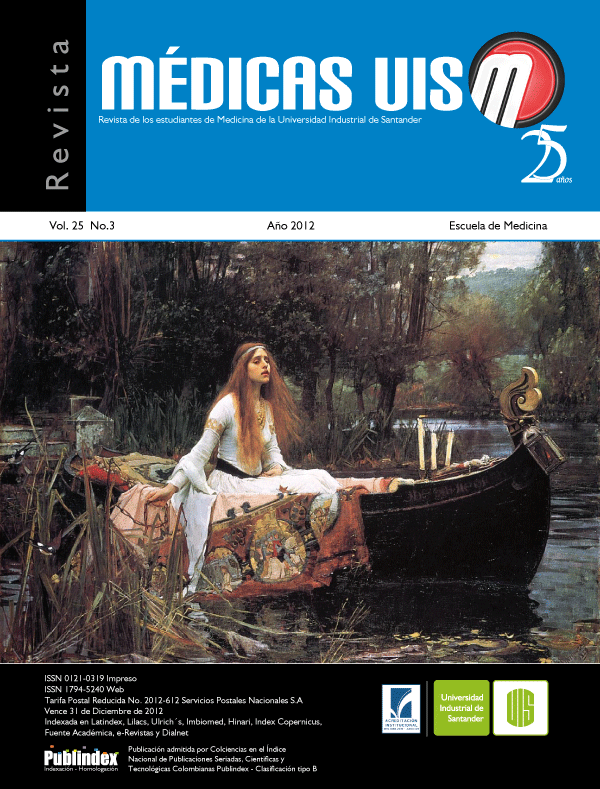Abstract
Introduction: leprosy is a chronic, infectious, granulomatous, transferable disease, although is not very contagious, caused by the bacillus Mycobacterium leprae that affects the skin, the outlying nerves, the mucous membrane of the breathing superior roads, the eyes and other structures. Objective: to identify the risk factors of the leprosy focused in health determinants, in those that study the human biology, condition and lifestyles, environment, organization of the health services and the socioeconomic base. Materials and methods: observational descriptive study of traverse character, the universe of the study was constituted by the 27 cases of leprosy notified in the county of Pinar del Río, Cuba, from January of 2009 to May of 2011. To obtain the information the cards of mandatory declaration and the epidemic surveys were revised. It was used as summary measure the absolute frequencies and the percentage. Results: the main risk factors identified were: in the element of the human biology, the multibacilar infection; in the environment, the risk of the coexistence with a patient with positive baciloscopy test; in the organization of the health attention, spontaneous detection of the leprosy cases; as for the lifestyles, the individual behavior of the migrations, and in a general way in the socioeconomic base 40,7% of the patients had low school level. (MÉD.UIS. 2012;25(3):203-8).
References
2. Blanco Córdova C.A, Cangas García T. Lepra. Impacto psicosocial. Enferm glob. 2012;11(25):25-30. Disponible en: http://dx.doi.org/10.4321/S1695-61412012000100018.
3. Rivero Reyes E, Barrios Martínez Z, Berdasquera Corcho D, Tápanes Fernández T, Peñalver Sinchay AG. La lepra, un problema de salud global. Rev Cubana Med Gen Integr. 2009;25(1):156-7. Disponible en: http://scielo.sld.cu/scielo.php?pid=S08641252009000100010&script=sci_arttext.
4. Cordero RF. La lepra en el mundo. Rev Fac Med. 2010 Nov; 53(6):102-5.
5. Soprani dos Santos A, Silveira de Castro D, Falqueto A. Fatores de risco para transmissão da Hanseníase. Rev Bras enferm Brasilia. 2008;61:738-43. Disponible en: http://www.scielo.br/pdf/reben/v61nspe/a14v61esp.pdf.
6. Nardi SMT, Marciano LHSC, Virmound MCL, Baccarelli R. Sistemas de informação e deficiências físicas na Hanseníase. Bol Epidemiol Paul. 2007;52(27):23-30. En: http://www.scielo.br/scielo.php?pid=S0104-11692007000700010&script=sci_arttext.
7. Chaves Monteiro da Cunha MH, Moraes de Macedo GM, Madureira Batista KN, Brasil Xavier M, De Sá Neto S, Souza do Nascimento e Nascimento F. Clinical and epidemiologycal evaluation of multibacillary patients from a reference center for leprosy in the brazilian amazon. Hansen int. 2008;33(2):9-16. Disponible en: http://periodicos.ses.sp.bvs.br/scielo.php?script=sci_arttext&pid=S1982-51612008000200002&lng=en&nrm=iso.
8. Oramas Fernández DK, Cruzata Rodríguez L, Sotto Vargas JD, Poulot Limonta S. Comportamiento de la lepra en dos policlínicos del municipio La Lisa. Rev Cubana Med Gen Integr. 2009;25(4):113-40. Disponible en: http://scielo.sld.cu/scielo. php?pid=S086421252009000400008&script=sci_arttex.
9. Cortez Franco DF, Ángeles Paredes L. Lepra indeterminada. Dermatol peru. 2007;14(2):1405-8. Disponible en: http://revistas.concytec.gob.pe/scielo.php?pid=S102871752004000200009&script=sci_arttext.
10. Acosta Piedra Y, Piedra Herrera B, Bandera Rodríguez O, Suárez Díaz T. Tuberculosis pulmonar en un paciente con lepra lepromatosa. Presentación de un caso. Rev. Med. Electrón. 2011;33(1):11-32. Disponible en: http://scielo.sld.cu/scielo.php?script=sci_arttext&pid=S16848242011000100016
11. Félix Lana FC, Mendes Carvalho AP, Ferraz Lopez Davi R. Perfil epidemiológico de la lepra en la micro región de araçuaí y su relación con las acciones de control. Esc Anna Nery. 2011;15(1):62-7. Disponible en: http://www.scielo.br/pdf/ean/v15n1/09.pdf.
12. Matos RO, de Souza Monteiro AP, de Barros Pontes L, do Socorro dos Santos Campos M, Ribeiro Teixeira R. Tratamento da hanseníase em uma unidade básica de saúde. Rev Para Méd. 2002;16(4):37-40. Disponible en: http://bases.bireme.br/cgi-bin/wxislind.exe/iah/online/?IsisScript=iah/iah.xis&src=google&base=LILACS&lang=p&nextAction=lnk&exprSearch=331810&indexSearch=ID.
13. Álvarez Yabor VJ, Morales Solís M, González Rodríguez A, Peña Pérez O. Caracterización de la lepra en la provincia de Las Tunas en el quinquenio 2004 - 2008. Rev modules. 2010;35(2):3-25. Disponible en: http://www.ltu.sld.cu/revista/modules.php?name=News&file=article&sid=9.
14. Cassamassimo Duarte MT, Aparecido Ayres J, Pessuto Simonetti J. Socioeconomic and demographic profile of leprosy carriers attended in nursing consultations. Rev Latino América Enfermagem. 2007;15(4):2114-7. Disponible en: http://www.scielo.br/scielo.php?pid=S010411692007000700010&script=sci_arttext.
15. Montenegro Valera I, Prior García A, Uribe-Echeverría Delgado AI, Soler Cárdenas SF, Durán Marrero K. Conocimientos de los médicos de familia sobre lepra. Rev Cubana Med Gen Integr. 2006;22(3):15-23. Disponible en: http://scielo.sld.cu/scielo.php?pid=S08641252006000300007&script=sci_arttext.
16. Hernández Ramos JM, Dutra Souto FJ. . Disability after treatment among leprosy patients in Várzea Grande, State of Mato Grosso. Rev Soc Bras Med Trop. 2010;43(3):12-25. Disponible en: http://dx.doi.org/10.1590/S0037-86822010000300016.
17. Fuertes C, Martín Laso MA. El inmigrante en la consulta de atención primaria. Anales Sis San Navarra. 2006;29(1):11-37. Disponible en: http://scielo.isciii.es/pdf/asisna/v29s1/original1.pdf
18. Fernández Sacasas JA, Díaz Novás J. Algunas consideraciones teóricas sobre la pesquisa activa. Rev Cubana Med Gen Integr. 2009;25(4):10-30. Disponible en: http://scielo.sld.cu/scielo.php?pid=S0864-21252009000400011&script=sci_arttext.
19. Palú Orozco A, Orozco González MI, Batista Duharte A, Pérez Pérez IM, García Vidal A. Principales aspectos inmunológicos en familias con casos secundarios de lepra en el área de salud “Frank País García”. MEDISAN. 2011;15(1):15-8. Disponible en: http://scielo.sld.cu/scielo.php?pid=S102930192011000100007&script=sciarttext.
